In the ever-evolving world of dog training, methods and philosophies are constantly being reassessed to ensure the well-being and happiness of our canine companions. One approach that has sparked considerable debate over the years is Alpha Dog Training. This method, rooted in the belief that dog owners must establish themselves as the “alpha” or pack leader, has been a staple for many. However, with advances in animal behavior science and a growing emphasis on positive reinforcement, some experts are questioning whether Alpha Dog Training is becoming outdated. In this article, we’ll explore the principles behind this traditional approach, examine the criticisms it faces, and consider alternative methods that might better suit the needs of modern dog owners and their furry friends. Whether you’re a seasoned dog owner or new to the world of canine care, understanding the dynamics of these training techniques can help you forge a stronger, more harmonious bond with your pet.
Understanding the Alpha Dog Training Philosophy
The concept of the alpha dog training philosophy is rooted in the idea that dogs are pack animals, and they naturally seek a leader to follow. This approach emphasizes the importance of establishing oneself as the dominant figure in the dog’s life to ensure obedience and respect. However, it’s crucial to distinguish between dominance and aggression; the goal is to be a calm and assertive leader, not a tyrant.
- Leadership Through Consistency: Establishing routines and consistent rules helps create a sense of stability for your dog, fostering an environment where they feel secure and understand their role within the ‘pack’.
- Positive Reinforcement: While the alpha philosophy traditionally focuses on dominance, integrating positive reinforcement can encourage desired behaviors without resorting to fear-based tactics.
- Understanding Canine Communication: Observing body language and vocal cues allows you to communicate effectively, ensuring your dog knows what is expected of them.
While the alpha approach has been influential, it’s important to adapt and integrate modern, humane training methods that prioritize the well-being of your dog. Emphasizing leadership without intimidation ensures a harmonious relationship built on trust and respect.
The Science Behind Modern Canine Behavior Techniques
In recent years, there has been a shift in understanding how dogs learn and interact with humans, steering away from the once-popular “alpha dog” training methods. Modern canine behavior techniques are deeply rooted in scientific research, focusing on positive reinforcement and understanding the cognitive and emotional needs of dogs. Studies have shown that dogs are more responsive to training methods that build trust and cooperation rather than fear and dominance.
These innovative approaches often include the following components:
- Positive Reinforcement: Rewarding desired behavior encourages dogs to repeat those actions.
- Operant Conditioning: Utilizing the principles of behavior modification to shape a dog’s actions.
- Understanding Canine Communication: Recognizing body language and vocal cues to better interpret a dog’s needs and emotions.
By embracing these science-backed techniques, trainers and pet owners can foster a more harmonious and fulfilling relationship with their furry companions, making outdated methods like alpha training a thing of the past.
Building Trust and Respect with Positive Reinforcement
Positive reinforcement is at the heart of a more humane and effective approach to dog training, fostering an environment where both trust and respect can flourish. By focusing on rewarding desired behaviors rather than punishing unwanted ones, you create a bond built on mutual understanding and encouragement. This method not only enhances the learning experience for your dog but also strengthens your relationship, making it a rewarding journey for both parties involved.
- Increased Motivation: Dogs are naturally eager to please and are more likely to repeat behaviors that earn them rewards.
- Improved Communication: Reinforcing positive actions helps your dog understand what is expected, leading to clearer communication.
- Reduced Anxiety: Eliminating harsh corrections reduces stress and anxiety, resulting in a more confident and well-adjusted pet.
By integrating positive reinforcement into your training regimen, you are investing in a compassionate approach that prioritizes the emotional well-being of your furry companion. This method not only promotes a more harmonious living environment but also encourages lifelong learning and adaptation, making it a valuable tool for nurturing a respectful and trusting relationship.
Practical Tips for Transitioning to Gentle Training Methods
Embracing a more empathetic approach to dog training requires a shift in mindset and techniques. Here are some practical tips to ease this transition:
- Understand Canine Communication: Invest time in learning how dogs communicate through body language and vocalizations. This understanding will help you respond appropriately and build a strong, trusting bond.
- Focus on Positive Reinforcement: Reward your dog with treats, praise, or play for good behavior. This encourages repetition of desired actions and creates a positive learning environment.
- Set Realistic Expectations: Remember that each dog is unique, and progress may be gradual. Celebrate small victories and remain patient, adjusting techniques as necessary.
- Seek Professional Guidance: If you’re struggling with the transition, consider consulting a certified dog trainer who specializes in gentle methods. They can offer personalized advice and support.
By adopting these strategies, you’ll foster a harmonious relationship with your canine companion, rooted in mutual respect and understanding.

